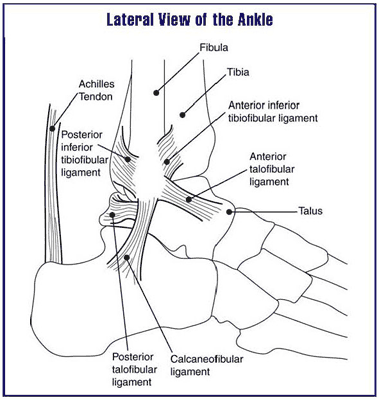The ankle joint is made up of the bones of the lower leg, the tibia and the fibula, which rest on top of the ankle bone known as the talus. These bones are held together by strong ligaments that allow us to put several times our body weight through the joint whilst doing actions like running, jumping, twisting etc.
When an ankle sprain occurs, the ligaments around the joint become stretched and torn causing pain, swelling and can give the feeling of joint instability. But not all sprains are equal and the location and mechanism of injury can play a significant role in how your injury is managed.
What is a high ankle sprain and how is it different from a common ankle sprain?

A high ankle sprain, also known as a syndesmotic injury, is an injury to the ligaments that hold the bones of the lower leg (tibia and fibula) together at the ankle joint. Together they are referred to as the syndesmosis ligaments but the anterior inferior tibiofibular ligament (AITFL) is the most commonly affected structure.
In contrast, a "common" ankle sprain, which is the more likely injury, involves disruption of the ligaments that hold the ankle bone (talus), to the lower leg bones.
The most common mechanism of injury for a high-ankle sprain is when someone falls or lands awkwardly on their foot whilst turning or performing a cutting motion. Hence it is a common occurrence in sports such as basketball, soccer, football, hockey, lacrosse, tennis and volleyball.
Due to the high energy normally required to cause a high ankle sprain this injury is usually associated with other foot and ankle injuries - osteochondral injuries (injuries to the surface of joints) occurs in 15-25% of cases.
What are the symptoms of a high ankle sprain?
A person who has sustained this kind of injury will often have difficulty walking because they cannot support their body weight on the injured limb. Depending on the severity of the injury, the pain may radiate up the leg from the ankle every time you try to take a step. This is because the tibiofibular joint will try to separate due to the syndesmotic ligaments holding them together no longer functioning.
There may be very little swelling around the ankle following a high ankle sprain so it is easy to underestimate the severity of an injury.
On clinical evaluation, the location of your pain may be focused on an area just above the ankle joint line.
How to treat a high ankle sprain?
To know how to best manage your injury, we will first need to know the severity. This means you will undergo investigations such as weight-bearing x-rays (not always a pleasant experience soon after an injury) and MRI scans of the ankle joint.
Treatment depends upon the degree of damage caused by the initial trauma. If there is only minor soft tissue damage then immobilisation using a boot or cast could suffice. However, if there is significant structural damage to the ligamentous structures then surgery will need to be considered otherwise you risk getting complications of chronic ankle instability.
Once the syndesmosis joint is stable, you will undergo physical therapy to help restore your ankle function.
How long does it take to recover from a high ankle sprain?
A low-grade high ankle sprain, treated non-operatively, can take anywhere between 6-8 weeks to recover from. However, if surgery is needed then recovery times, that is time to return to sports, can vary significantly. In some cases taking 3 months or longer.
If it is not properly treated, it can lead to long-term problems including, loss of ankle range of motion and developing ankle arthritis.
If you think you have sustained a high ankle sprain, you should arrange to see a doctor immediately. Click here to schedule an appointment.
